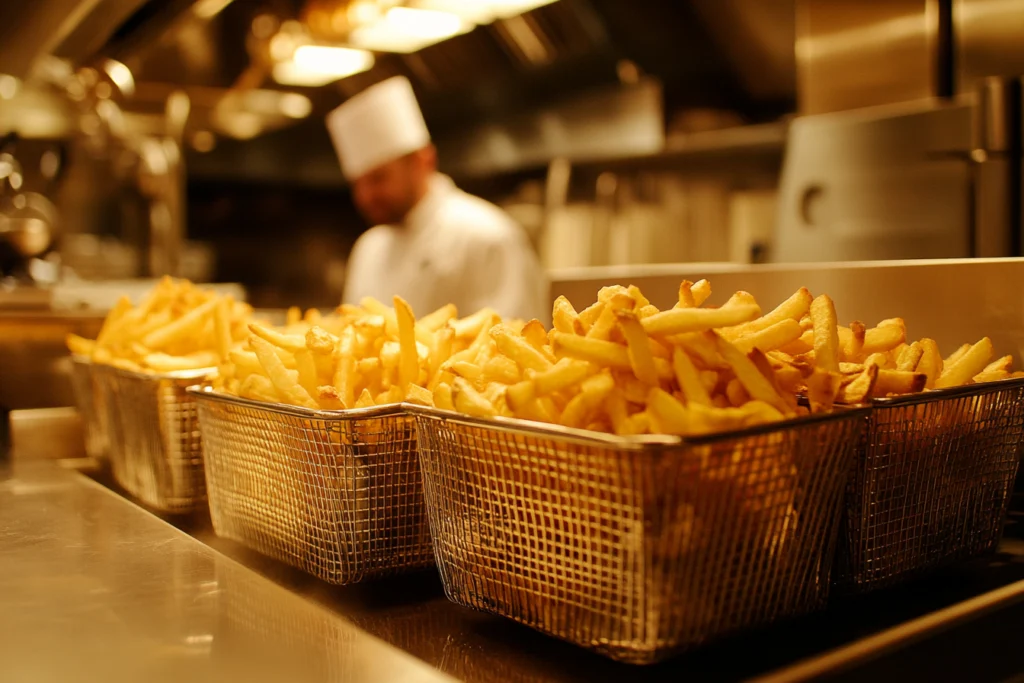French fries are universally loved, but there is more to these crispy delights than just their taste. Many people wonder about the different types of costs associated with French fries, specifically the difference between French fries sales and French fries fees. In this article, we will explore these terms in detail, providing a comprehensive understanding of how they relate to the food industry. Whether you are a business owner or simply someone interested in the behind-the-scenes aspects of the food business, this guide will clarify these often misunderstood concepts.
Understanding French Fries Sales
French fries sales refer to the revenue generated from selling French fries. This is a straightforward concept: any business selling French fries, such as a restaurant, food truck, or a fast-food chain, earns money from these sales. The pricing of French fries can vary depending on several factors, including the location of the establishment, the quality of ingredients used, and the brand value. High-quality, organic French fries sold in upscale restaurants may command higher prices compared to those sold in fast-food outlets.
French fries sales contribute to the overall revenue of the food establishment and are influenced by marketing, branding, and customer loyalty. Many businesses employ promotions, discounts, and meal deals to drive up sales and attract more customers.
Factors Affecting French Fries Sales
- Seasonal Trends: Sales of French fries can fluctuate based on seasonal trends. For instance, during the summer months, many fast-food joints see an increase in sales due to outdoor gatherings, fairs, and festivals. The winter holiday season can also drive sales as people indulge in comfort foods, and French fries are often part of that comfort.
- Menu Placement and Presentation: The placement of French fries on a menu can significantly affect their sales. Strategically placing French fries under “recommended sides” or bundling them with main dishes can boost sales. Moreover, the visual presentation of French fries, such as using vibrant images and mouth-watering descriptions, can entice customers to purchase them.
- Consumer Preferences and Health Trends: In recent years, there has been a shift in consumer preferences, with many people opting for healthier food options. This trend has impacted French fries sales, especially for fast-food chains. In response, many businesses have introduced healthier versions of French fries, such as those baked rather than fried, or made from sweet potatoes. These options cater to health-conscious customers and help maintain or even increase French fries sales.
- Promotions and Deals: Promotions and deals play a crucial role in driving French fries sales. Offering combo meals or discounts on French fries can make them more appealing to customers. Businesses can also offer loyalty programs where customers earn rewards or discounts for purchasing French fries, further boosting sales.
- Customer Experience and Reviews: The overall experience customers have at an establishment can significantly impact sales. If the French fries are consistently hot, crispy, and delicious, customers are more likely to leave positive reviews and recommend the establishment to others. Positive word of mouth can lead to increased sales and customer retention.
French Fries Fees Explained

In contrast, French fries fees refer to additional costs associated with preparing and serving French fries. These fees can include the cost of ingredients, labor, overhead expenses, and even licensing fees. For instance, businesses may have to pay certain licensing or franchise fees if they use specific proprietary recipes or brand names. Additionally, restaurants often incur fees related to logistics, such as the transportation of ingredients and waste management.
It is also important to understand that these fees directly affect the pricing of French fries in the market. To cover these costs, businesses might adjust the selling price to ensure profitability. French fries fees are a crucial component in determining the cost structure and profitability margins for any food service establishment.
Components of French Fries Fees
- Ingredient Costs: The cost of ingredients is a major component of French fries fees. This includes not only the potatoes but also oil, salt, and any additional seasonings. Depending on the quality of the ingredients and market fluctuations, these costs can vary significantly. For example, organic or locally sourced potatoes may be more expensive than conventional options, thus increasing the overall fees.
- Labor Costs: Labor costs encompass the wages paid to employees involved in the preparation and serving of French fries. This includes kitchen staff, servers, and even those involved in cleaning and maintenance. Higher wages or increased labor demands, such as during peak hours, can raise the fees associated with French fries.
- Overhead Costs: Overhead costs include utilities, rent, equipment maintenance, and other operational expenses. These costs are indirectly related to the preparation of French fries but are essential for the business to function. For instance, the cost of maintaining fryers, buying oil filters, and keeping the kitchen running smoothly are all part of the overhead fees that affect French fries pricing.
- Waste Management: French fries production inevitably generates waste, whether it is potato peelings, used cooking oil, or leftover food. Proper disposal and waste management practices can be costly, particularly if a business aims to follow environmentally friendly practices. These fees are part of the overall costs that need to be covered by the sale price of French fries.
- Licensing and Franchise Fees: For franchise-based businesses, there may be additional licensing or royalty fees. These fees are paid to the franchisor for the use of proprietary recipes, branding, and marketing support. Such fees add to the overall cost structure of French fries and influence their final pricing.
Managing French Fries Fees

To manage French fries fees effectively, businesses must be proactive in controlling costs. This can be achieved by:
- Bulk Purchasing: Buying ingredients in bulk can help reduce the cost per unit, leading to lower overall ingredient costs. Establishing relationships with suppliers and negotiating contracts can lead to cost savings.
- Efficient Labor Management: Scheduling staff efficiently and minimizing overtime can help reduce labor costs. Training employees to work more effectively and avoid waste can also contribute to cost management.
- Energy Efficiency: Investing in energy-efficient kitchen appliances can help reduce utility costs. Fryers that consume less energy or have better heat retention can lead to lower overhead expenses.
- Waste Reduction: Implementing strategies to minimize food waste, such as using potato scraps in other menu items or recycling used cooking oil, can help reduce waste management costs.
Factors Influencing Sales and Fees
Quality of Ingredients
The quality of the ingredients plays a significant role in determining both French fries sales and French fries fees. High-quality, organic potatoes and special seasoning mixes can increase production costs, thereby affecting the fees. However, the use of high-quality ingredients often translates into better sales, as customers are willing to pay a premium for superior taste.
The type of oil used for frying also impacts both the fees and sales. Health-conscious consumers may prefer French fries cooked in healthier oils, such as sunflower or olive oil, rather than traditional vegetable oil. While these healthier options may increase production costs, they can also attract more customers, thereby boosting sales.
Nature of the Business
The nature of the business also determines the distinction between French fries sales and fees. Fast-food chains may have standardized processes that minimize costs, thus reducing the French fries fees. Meanwhile, gourmet restaurants might use artisanal methods to prepare French fries, which raises both production costs and, subsequently, the price paid by the customer. This ultimately influences sales depending on the customer demographic the business is targeting.
Fast-food chains often benefit from economies of scale, meaning they can purchase ingredients in larger quantities at reduced prices. This helps keep their fees lower compared to smaller establishments that might not have the same purchasing power. On the other hand, gourmet or niche restaurants that focus on quality and uniqueness may have higher fees but also attract customers who are willing to pay more for a premium product.
Location and Overhead Costs
Location is another critical factor that affects both sales and fees. Restaurants in high-rent areas tend to have higher overhead costs, which are included in French fries fees. These increased costs often lead to higher pricing for French fries, which can affect overall sales depending on the purchasing power of the local clientele. On the other hand, businesses in low-cost areas might be able to sell French fries at a lower price, which can help boost sales volume.
Overhead costs are also influenced by local regulations and taxes. For example, some cities may impose higher taxes on fast food, which can increase the fees associated with French fries. In such cases, businesses may need to adjust their pricing strategies to maintain profitability while staying competitive in the market.
How to Balance Sales and Fees Effectively
Balancing French fries sales and fees requires strategic planning. One approach is to manage the supply chain effectively by sourcing ingredients at a reasonable cost without compromising quality. Additionally, marketing campaigns can play a key role in increasing sales volume, helping offset the fees associated with production and overhead.
Businesses can also explore partnerships with local farms or suppliers to reduce ingredient costs. By sourcing potatoes locally, businesses may be able to lower transportation fees and support the local economy, which can also be a selling point for customers who value sustainability.
Incorporating sustainable practices can also help reduce certain fees. For example, minimizing food waste or using energy-efficient appliances can reduce overhead expenses, thus making it easier for the business to maintain competitive pricing for their French fries.
Tips for Maximizing French Fries Profitability
- Use Asynchronous Sources of Ingredients: Sourcing potatoes and other ingredients from different suppliers helps maintain consistent quality while potentially reducing costs. Businesses can benefit from price fluctuations by purchasing from suppliers offering the best deals at any given time.
- Monitor Sales Data: Analyze sales data to identify trends and peak demand periods to optimize pricing and promotions. Understanding customer preferences and behaviors can help businesses adjust their strategies to maximize sales and minimize costs.
- Sustainable Practices: Reduce waste and save on overhead fees by using eco-friendly equipment and practices. For instance, reusing cooking oil in a safe manner or implementing a waste reduction program can lead to significant cost savings.
- Customer Engagement: Engaging with customers through social media and loyalty programs can help drive sales. Offering exclusive discounts or promotions to loyal customers can encourage repeat business and increase overall profitability.
- Innovative Menu Options: Adding new flavors or variations of French fries can attract more customers. For instance, offering loaded fries with toppings such as cheese, bacon, or truffle oil can create a premium product that justifies a higher price point, thereby increasing both sales and profitability.
- Bundle Offers: Bundling French fries with popular main dishes can make them more appealing and encourage customers to purchase a full meal. This strategy not only boosts French fries sales but also increases overall revenue per transaction.
- Leveraging Technology: Utilizing technology such as POS (point of sale) systems and online ordering platforms can help streamline operations and reduce costs. POS systems can track inventory levels and optimize supply chain management, while online ordering platforms can attract more customers by offering convenience.
Frequently Asked Questions
What is the mark of shipped French fries?
The mark of shipped French fries refers to the brand or quality label indicating where and how the fries have been produced and processed, ensuring they meet specific standards.
What are the different types of French fries?
There are numerous types of French fries, including shoestring, steak, curly, crinkle-cut, and waffle fries. Each type offers a different texture and flavor experience.
What does shipped French fries contain?
Shipped French fries typically contain pre-cut and sometimes pre-cooked potatoes, which may be frozen or chilled. They also contain preservatives to maintain freshness during transportation.
What are the different types of chargers?
In the context of food services, “chargers” could refer to devices used for carbonating beverages or, more generally, additional costs incurred during meal preparation, such as for specialty equipment or premium packaging.

